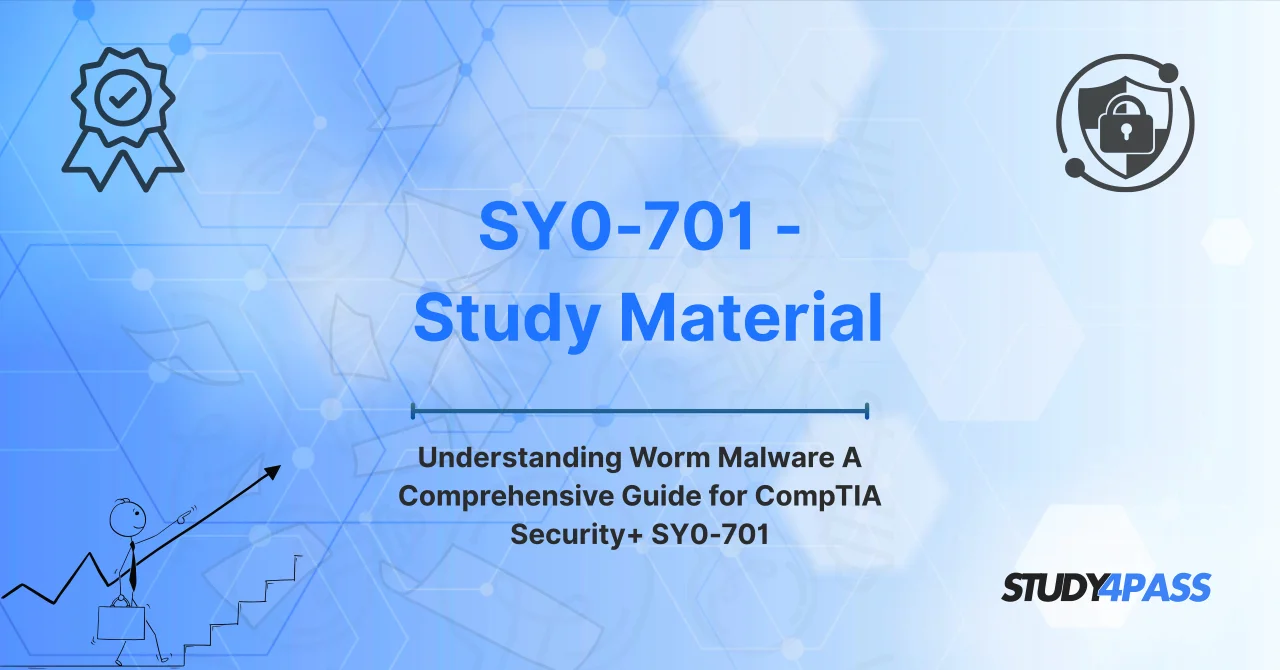Introduction to the CompTIA SY0-701 Exam
The CompTIA Security+ SY0-701 certification is a globally recognized credential that validates foundational cybersecurity skills. As cyber threats evolve, the exam emphasizes real-world scenarios, including malware analysis, incident response, and threat mitigation. One critical topic in the SY0-701 exam is worm malware, a self-replicating threat that can devastate networks.
At Study4Pass, we specialize in breaking down complex cybersecurity concepts into digestible lessons. This blog will explore how worms operate, their impact, and strategies to combat them—all aligned with the SY0-701 exam objectives. Whether you’re preparing for the exam or reinforcing your cybersecurity knowledge, this guide will equip you with actionable insights.
How Worms Spread
Worms are a type of malware designed to self-replicate and spread without human intervention. Unlike viruses, worms don’t require a host file or program to propagate. Instead, they exploit vulnerabilities in networks, operating systems, or applications.
Common Propagation Methods
-
Network Exploits:
Worms scan for devices with unpatched vulnerabilities. For example, the infamous Conficker worm exploited a Windows Server service vulnerability (MS08-067) to infect millions of systems. -
Email and Messaging:
Phishing emails with malicious attachments or links are a classic worm delivery method. The ILOVEYOU worm (2000) spread via email, tricking users into opening a malicious script disguised as a love letter. -
Removable Media:
Worms like Stuxnet spread via USB drives, targeting industrial control systems. -
Peer-to-Peer (P2P) Networks:
File-sharing platforms can host infected files that execute worms upon download. -
Cloud and IoT Devices:
Modern worms exploit misconfigured cloud storage or insecure IoT devices. The Mirai botnet infected thousands of IoT devices using default credentials.
Key Characteristics
-
Autonomous Propagation: Worms don’t need user interaction.
-
Payload Delivery: Many worms carry secondary payloads (e.g., ransomware, spyware).
-
Polymorphism: Advanced worms alter their code to evade detection.
Study4Pass Tip: Our SY0-701 course includes hands-on labs simulating worm propagation, helping you recognize attack patterns.
Impact of Worm Malware
The damage caused by worms extends far beyond initial infection.
Technical Consequences
-
Network Congestion: Mass replication can overload bandwidth (e.g., the SQL Slammer worm disrupted airline systems in 2003).
-
Data Corruption: Worms like Blaster modified system files, causing crashes.
-
Backdoor Creation: Worms often install backdoors for future attacks.
Business Risks
-
Financial Losses: Downtime, recovery costs, and regulatory fines.
-
Reputational Damage: Customers lose trust after breaches.
-
Operational Disruption: Critical services (healthcare, utilities) may halt.
Case Study: The WannaCry ransomware worm (2017) exploited EternalBlue, a Windows SMB vulnerability, causing $4 billion in global losses.
Detection and Prevention of Worms
Acing the SY0-701 exam requires understanding proactive and reactive defenses.
Detection Strategies
-
Network Monitoring: Tools like IDS/IPS detect unusual traffic patterns (e.g., rapid port scanning).
-
Endpoint Protection: Antivirus software with heuristic analysis identifies unknown worms.
-
Log Analysis: Centralized logging (SIEM) helps correlate events across systems.
Prevention Techniques
-
Patch Management: Regularly update OS and software to fix vulnerabilities.
-
Network Segmentation: Isolate critical systems to limit worm spread.
-
User Education: Train staff to avoid suspicious links and USB devices.
-
Email Filtering: Block malicious attachments and links.
Study4Pass Resource: Our SY0-701 practice exams include scenario-based questions on worm mitigation.
Incident Response and Mitigation
The SY0-701 exam tests your ability to respond to incidents swiftly.
Incident Response Plan (IRP)
-
Preparation: Develop an IRP with roles, communication channels, and tools.
-
Identification: Use monitoring tools to detect anomalies.
-
Containment: Isolate infected systems and disconnect them from the network.
-
Eradication: Remove worm components and patch vulnerabilities.
-
Recovery: Restore systems from clean backups.
-
Lessons Learned: Update policies to prevent recurrence.
Example: During the Nimda worm outbreak (2001), organizations that disabled unnecessary services (e.g., file sharing) contained the damage faster. Study4Pass Advantage: Our video tutorials walk you through real-world IRP simulations.
Worm Malware in CompTIA Security+ SY0-701
The SY0-701 exam objectives explicitly cover malware analysis and response:
-
Domain 1.0: Threats, Attacks, and Vulnerabilities:
-
Analyze indicators of worm activity (e.g., unusual outbound traffic).
-
Domain 2.0: Architecture and Design:
-
Implement secure network designs to limit worm propagation.
-
Domain 4.0: Operations and Incident Response:
-
Execute IRP steps during a worm outbreak.
Study4Pass Alignment: Our course mirrors CompTIA’s exam blueprint, with flashcards, quizzes, and cheat sheets focused on worm-related scenarios.
Conclusion
Worm malware remains a persistent threat in cybersecurity, making it a cornerstone of the SY0-701 exam. By understanding propagation methods, impacts, and mitigation strategies, you’ll be well-prepared to tackle exam questions and real-world incidents.
At Study4Pass, we combine expert-led training with practical resources to ensure your success. Enroll in our SY0-701 course today to master worm malware and 50+ other exam topic.
Special Discount: Offer Valid For Limited Time “SY0-701 Sample Questions”
Sample Questions For CompTIA Security+ SY0-701 Official Guide
What is a key characteristic of a worm malware?
A) It requires user interaction to propagate.
B) It only spreads through email attachments.
C) It can self-replicate and spread without user intervention.
D) It is always harmless and used for research purposes.
Which of the following is a common propagation method used by worms?
A) Physical USB drives only
B) Exploiting network vulnerabilities
C) Requiring manual execution by the user
D) Only infecting BIOS firmware
How does a worm differ from a virus?
A) A worm requires a host file to spread, while a virus does not.
B) A worm can spread independently, while a virus needs user action.
C) A worm only affects Linux systems, while a virus affects Windows.
D) A worm is less harmful than a virus.
Which of the following is a real-world example of a worm malware?
A) CryptoLocker
B) ILOVEYOU
C) WannaCry
D) Stuxnet
What is a recommended defense strategy against worm malware?
A) Disabling all firewalls to speed up network traffic
B) Regularly updating systems and applying security patches
C) Allowing unrestricted user permissions on all devices
D) Ignoring network segmentation for easier access


